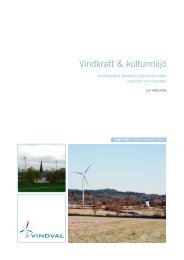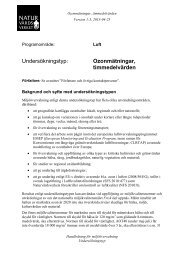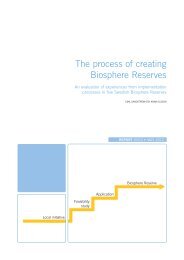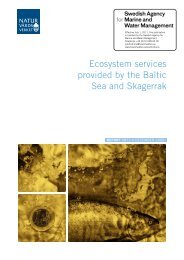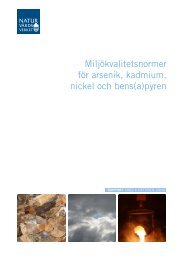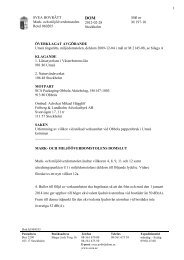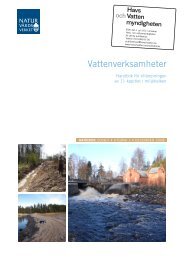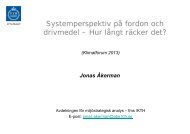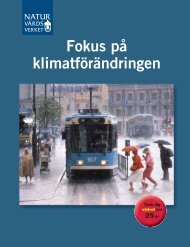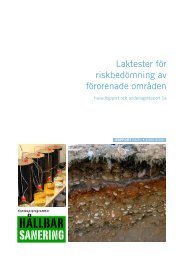pdf 4,3 MB - Naturvårdsverket
pdf 4,3 MB - Naturvårdsverket
pdf 4,3 MB - Naturvårdsverket
Create successful ePaper yourself
Turn your PDF publications into a flip-book with our unique Google optimized e-Paper software.
HÅLLBAR SANERING<br />
Rapport 5663 - Klorerade lösningsmedel<br />
Another major exposure pathway, besides groundwater transport, is through gas<br />
migration because chlorinated aliphatic compounds generally have a very high<br />
vapor pressure. Gaseous transport of magnitude may not only occur from the<br />
source area but also from the contaminated groundwater.<br />
There are a number of pathways through which human beings can be exposed<br />
to chlorinated solvents and their degradation products. Chlorinated solvents are<br />
most commonly found at such depths in the soil that direct exposure through<br />
contact with soil does not constitute a major risk. Instead, exposure through inhalation<br />
is generally considered to be the most prevalent exposure pathway. Evaporation<br />
and gaseous transport do not exclusively occur in the source area, but also<br />
above a contaminated groundwater from which chlorinated solvent vapors can be<br />
transported through the soil layers and into overlying buildings. Exposure through<br />
contaminated drinking water may also constitute an important exposure pathway.<br />
There is a high variability between different chlorinated solvent compounds<br />
regarding their human health hazards. The hazards range from moderate to very<br />
high. Vinyl chloride is a known carcinogen while others are potentially carcinogenic.<br />
Ecotoxicological hazards also have a high variability within this group of<br />
compounds.<br />
Even though chlorinated solvents have been handled at numerous sites across<br />
the country, with a high probability of soil and groundwater contamination as a<br />
result, there is very limited knowledge regarding the scope of the problem in<br />
Sweden. Thorough and systematic on site investigations and remedial actions<br />
focusing on chlorinated solvents has only been performed at a very limited number<br />
of sites. This stands in contrast to the situation in several European countries and<br />
North America where the problem of chlorinated solvent contamination has<br />
received more attention and higher priority when planning remedial actions.<br />
Site investigations and remedial actions used for these contaminants involve<br />
bigger challenges compared to e.g. petroleum hydrocarbons. One of the major<br />
challenges during the investigation phase is to localize and delineate the con-<br />
taminant source and migration pathways. During remediation, the extensive coverage<br />
of contamination and the distribution between different environmental media<br />
has the consequence that no single method is usually sufficient to reach predetermined<br />
remedial action objectives. The usage of one method within the source area<br />
and another within the plume is not unusual. Furthermore, complementary remedial<br />
actions may have to be considered that prevent or limit groundwater migration so<br />
that an acceptable risk reduction level can be achieved.<br />
There is an abundance of technologies to choose from when considering the<br />
most appropriate remedial technology for a given site. Some methods that are<br />
commonly used to treat fuel hydrocarbons and other organic contaminants are also<br />
applicable to chlorinated solvents remediation, while a number of other methods<br />
are more specifically designed for chlorinated solvents. There has been significant<br />
research and development of chlorinated solvent remediation technologies since<br />
the late 1980’s. The knowledge base regarding the fate and behavior of chlorinated<br />
solvents in soil and groundwater has also been considerably expanded. This is<br />
13



